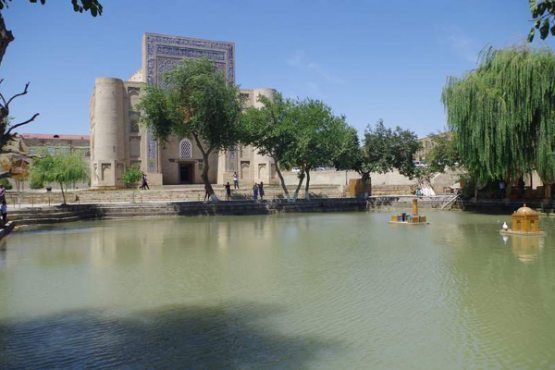A pond in Bukhara that has not dried up for 400 years
🔴The chance to see history reflected in water
🔴The legacy of 17th-century architects that still amazes today

Bukhara is not only the spiritual center of Central Asia but of the entire Eastern world. History is felt in every street of the city. One of its most unique landmarks is the Labi-Hovuz complex, which has not lost its significance over the centuries.
Why “Labi-Hovuz”?
“Labi-Hovuz” means “by the pond” in Persian. This is no coincidence the artificial pond at the heart of the complex served as the city’s drinking water source for centuries.
From the 17th Century to Today
Labi-Hovuz was built between 1620 and 1623 during the reign of Amir Abdullaziz Khan at the initiative of Nadir Devonbegi. The main structures of the complex include:
◾️Kukaldosh Madrasa – a major religious educational center with more than 160 hujras (cells)
◾️Nadir Devonbegi Khanqah – a place for Sufi gatherings and ceremonies
◾️Nadir Devonbegi Madrasa – originally a caravanserai, later turned into a madrasa
The pond measures 42×36 meters and holds up to 4,300 cubic meters of water, supplied via the Shahrud canal.
A center of cultural life
Today, Labi-Hovuz is one of the most beautiful places in Bukhara, serving as a space for leisure, concerts, and cultural events for locals and tourists alike. The centuries-old mulberry and sophora trees around it provide cool shade in the summer.

The statue of Khoja Nasrullo Afandi
Another distinctive feature of the complex is the statue of Khoja Nasrullo Afandi, a symbol of humor and wisdom among the people. He is depicted sitting on a donkey with his hand on his heart and a sincere smile one of the most popular photo spots for visitors.
Labi-Hovuz – model and modern tourism center
Today, among the more than 80 historical models being prepared at the Museum of the Center of Islamic Civilization in Uzbekistan, there is also a model of Labi-Hovuz. This helps preserve historical heritage and pass it on to new generations. Around Labi-Hovuz, local handicrafts are sold, national restaurants operate, and evening concerts and live music events are held.
Labi-Hovuz is the cultural face of Bukhara a symbol of peace, tranquility, and conversation, carrying the heartbeat of the city through the centuries.
Guzal Beknazarova
P/S: This article may be used by citing the official website of the Center.
Most read

More than 80 historical artifacts related to Uzbekistan are planned to be returned to our country

An extended meeting of the Scientific Council took place at the Center of Islamic Civilization

About a house even greater than the Kaaba...











